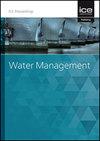进口水力学中使用的流量系数
IF 0.9
4区 工程技术
Q3 ENGINEERING, CIVIL
Proceedings of the Institution of Civil Engineers-Water Management
Pub Date : 2023-08-21
DOI:10.1680/jwama.22.00059
引用次数: 0
摘要
城市洪积洪水的产生或加剧可能是由于进水口密度不足或水力效率低下。对入口水力性能的适当关注对于保证城市排水系统在暴雨期间的正常运行至关重要。在流体力学建模领域中,计算分析的最新进展允许在设计和规划中使用众所周知的双重排水概念,通过对入口效率的适当水力表征来模拟表面层(街道)和地下层(下水道)之间的流动。目前,强大的商业软件包允许模拟流动传输,包括不同的方法和公式。这些方法中的许多方法都包括将下水道入口视为孔板的可能性。在这种情况下,本文提出了一种方法,以获得孔板流量系数的三个入口先前测试在加泰罗尼亚技术大学的水力实验室。所得结果表明,流量系数值在0.18 ~ 0.58之间,弗劳德数在1.12 ~ 4.4之间,与通常推荐值相差甚远。该程序甚至可以应用于未测试的栅极。本文章由计算机程序翻译,如有差异,请以英文原文为准。
Discharge coefficients to be used in inlet hydraulics
Urban pluvial floods can be produced or exacerbated by insufficient inlets density or by their poor hydraulic efficiency. A proper regard on inlet hydraulic performance is essential to guarantee the correct functioning of urban drainage systems during heavy storm events. The recent advances in computation analysis in the field of hydrodynamics modelling allow to use the well-known concept of dual drainage for design and planning purposes simulating flow transfers between surface layer (street) and underground layer (sewer) through a proper hydraulic characterization of inlet efficiency. Currently, powerful commercial software packages allow the simulation of flow transferring including different approaches and formulas. Many of these approaches include the possibility to treat sewer inlets as an orifice. In this context, this paper presents a methodology to obtain orifice discharge coefficients for three inlets previously tested at the Hydraulic Laboratory of the Technical University of Catalonia. Obtained results show discharge coefficient values between 0,18 and 0,58 with a Froude number between 1.12 and 4.4, quite far from usual recommended values. The procedure can be applied even to non-tested grates.
求助全文
通过发布文献求助,成功后即可免费获取论文全文。
去求助
来源期刊
CiteScore
2.10
自引率
0.00%
发文量
28
审稿时长
6-12 weeks
期刊介绍:
Water Management publishes papers on all aspects of water treatment, water supply, river, wetland and catchment management, inland waterways and urban regeneration.
Topics covered: applied fluid dynamics and water (including supply, treatment and sewerage) and river engineering; together with the increasingly important fields of wetland and catchment management, groundwater and contaminated land, waterfront development and urban regeneration. The scope also covers hydroinformatics tools, risk and uncertainty methods, as well as environmental, social and economic issues relating to sustainable development.

 求助内容:
求助内容: 应助结果提醒方式:
应助结果提醒方式:


